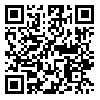BibTeX | RIS | EndNote | Medlars | ProCite | Reference Manager | RefWorks
Send citation to:
URL: http://jdisabilstud.org/article-1-2262-en.html
2- Assistant Professor of Psychology, Babol Branch, Islamic Azad University, Babol, Iran
3- Associate Professor of Sociology, Babol Branch, Islamic Azad University, Babol, Iran
Abstract
Background & Objectives: One of the variables influencing cyberspace orientation is emotions, which are associated with a wide range of problems. Psychological disorders, such as anxiety and depression, are regarded as disorders in cognitive–emotional function in which affected people cannot convey their experiences as feelings and perceptions that symbolize and express emotions. One of the most determining dimensions in people's tendency to cyberspace is the level of cognition and metacognition. Metacognition is also among the variables related to students' academic success and their academic processes. Considering the importance of students' academic success and their high tendency towards cyberspace and the negative effects of this problem, we developed a model of cyberspace orientation based on state metacognition mediated by positive and negative academic emotions in gifted female students in Ghaemshahr, Babol, and Sari cities, Iran.
Methods: This research was applied in terms of purpose and cross–sectional correlational in terms of the methodology using structural equation modeling. The study's statistical population comprised all gifted female students of the senior high schools in Ghaemshahr, Babol, and Sari cities in 2018–2019. According to the number of observed variables (17 observed variables in the model) and allocation of 15 samples for each variable, and considering the possibility of incomplete questionnaires, 350 people were selected as the sample size in an accessible manner. The inclusion criteria were as follows: lacking physical, movement, and vision disorders, not having speech disorders, and common mental disorders such as depression and anxiety (by referring to the student's file and getting help from the school psychologist). Dissatisfaction with participating in the research was considered as the exclusion criterion. Data collection tools were Cyberspace Questionnaire (Kalantari & Jafari, 2016), Achievement Emotions Questionnaire (Pekrun et al., 2011), and State Metacognition Questionnaire (O'Neill & Abedi, 1996). The collected data were analyzed using descriptive statistics, the Pearson correlation test, and structural equation modeling in SPSS version 19 and AMOS version 23 software. The significance level of the tests was 0.05.
Results: The results showed that state metacognition had a direct and significant effect on positive (p<0.001, β=0.94) and negative emotions (p<0.001, β=–0.19). Positive (p=0.001, β=–0.27) and negative emotions (p=0.002, β=0.16) directly and significantly affected the tendency toward cyberspace. State metacognition with the mediation of positive and negative emotions had an indirect and significant effect on the tendency to cyberspace (p=0.001, β=–0.29). State metacognition (p=0.001, β=–0.29), positive emotions (p=0.001, β=–0.27), and negative emotions (p=0.002, β=0.16) had significant total effects on the trend toward cyberspace. Examining the goodness of fit indices of the model revealed that the proposed model had a good fit with the data (χ2/df=2.421, RMSEA=0.038, GFI=0.973, NFI=0.971, CFI=0.996).
Conclusion: Based on the study findings, state metacognition and positive and negative academic emotions are very important variables that affect adolescents' tendency to cyberspace, and state metacognition mediated by positive and negative academic emotions can be a good model to explain the tendency of gifted female students to cyberspace.
| Rights and permissions | |
 |
This work is licensed under a Creative Commons Attribution-NonCommercial 4.0 International License. |



